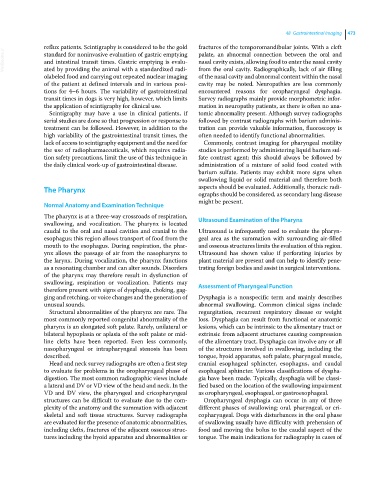Page 505 - Clinical Small Animal Internal Medicine
P. 505
48 Gastrointestinal Imaging 473
reflux patients. Scintigraphy is considered to be the gold fractures of the temporomandibular joints. With a cleft
VetBooks.ir standard for noninvasive evaluation of gastric emptying palate, an abnormal connection between the oral and
nasal cavity exists, allowing food to enter the nasal cavity
and intestinal transit times. Gastric emptying is evalu
ated by providing the animal with a standardized radi
of the nasal cavity and abnormal content within the nasal
olabeled food and carrying out repeated nuclear imaging from the oral cavity. Radiographically, lack of air filling
of the patient at defined intervals and in various posi cavity may be noted. Neuropathies are less commonly
tions for 4–6 hours. The variability of gastrointestinal encountered reasons for oropharyngeal dysphagia.
transit times in dogs is very high, however, which limits Survey radiographs mainly provide morphometric infor
the application of scintigraphy for clinical use. mation in neuropathy patients, as there is often no ana
Scintigraphy may have a use in clinical patients, if tomic abnormality present. Although survey radiographs
serial studies are done so that progression or response to followed by contrast radiographs with barium adminis
treatment can be followed. However, in addition to the tration can provide valuable information, fluoroscopy is
high variability of the gastrointestinal transit times, the often needed to identify functional abnormalities.
lack of access to scintigraphy equipment and the need for Commonly, contrast imaging for pharyngeal motility
the use of radiopharmaceuticals, which requires radia studies is performed by administering liquid barium sul
tion safety precautions, limit the use of this technique in fate contrast agent; this should always be followed by
the daily clinical work‐up of gastrointestinal disease. administration of a mixture of solid food coated with
barium sulfate. Patients may exhibit more signs when
swallowing liquid or solid material and therefore both
The Pharynx aspects should be evaluated. Additionally, thoracic radi
ographs should be considered, as secondary lung disease
might be present.
Normal Anatomy and Examination Technique
The pharynx is at a three‐way crossroads of respiration, Ultrasound Examination of the Pharynx
swallowing, and vocalization. The pharynx is located
caudal to the oral and nasal cavities and cranial to the Ultrasound is infrequently used to evaluate the pharyn
esophagus; this region allows transport of food from the geal area as the summation with surrounding air‐filled
mouth to the esophagus. During respiration, the phar and osseous structures limits the evaluation of this region.
ynx allows the passage of air from the nasopharynx to Ultrasound has shown value if perforating injuries by
the larynx. During vocalization, the pharynx functions plant material are present and can help to identify pene
as a resonating chamber and can alter sounds. Disorders trating foreign bodies and assist in surgical interventions.
of the pharynx may therefore result in dysfunction of
swallowing, respiration or vocalization. Patients may Assessment of Pharyngeal Function
therefore present with signs of dysphagia, choking, gag
ging and retching, or voice changes and the generation of Dysphagia is a nonspecific term and mainly describes
unusual sounds. abnormal swallowing. Common clinical signs include
Structural abnormalities of the pharynx are rare. The regurgitation, recurrent respiratory disease or weight
most commonly reported congenital abnormality of the loss. Dysphagia can result from functional or anatomic
pharynx is an elongated soft palate. Rarely, unilateral or lesions, which can be intrinsic to the alimentary tract or
bilateral hypoplasia or aplasia of the soft palate or mid extrinsic from adjacent structures causing compression
line clefts have been reported. Even less commonly, of the alimentary tract. Dysphagia can involve any or all
nasopharyngeal or intrapharyngeal stenosis has been of the structures involved in swallowing, including the
described. tongue, hyoid apparatus, soft palate, pharyngeal muscle,
Head and neck survey radiographs are often a first step cranial esophageal sphincter, esophagus, and caudal
to evaluate for problems in the oropharyngeal phase of esophageal sphincter. Various classifications of dyspha
digestion. The most common radiographic views include gia have been made. Typically, dysphagia will be classi
a lateral and DV or VD view of the head and neck. In the fied based on the location of the swallowing impairment
VD and DV view, the pharyngeal and cricopharyngeal as oropharyngeal, esophageal, or gastroesophageal.
structures can be difficult to evaluate due to the com Oropharyngeal dysphagia can occur in any of three
plexity of the anatomy and the summation with adjacent different phases of swallowing: oral, pharyngeal, or cri
skeletal and soft tissue structures. Survey radiographs copharyngeal. Dogs with disturbances in the oral phase
are evaluated for the presence of anatomic abnormalities, of swallowing usually have difficulty with prehension of
including clefts, fractures of the adjacent osseous struc food and moving the bolus to the caudal aspect of the
tures including the hyoid apparatus and abnormalities or tongue. The main indications for radiography in cases of

